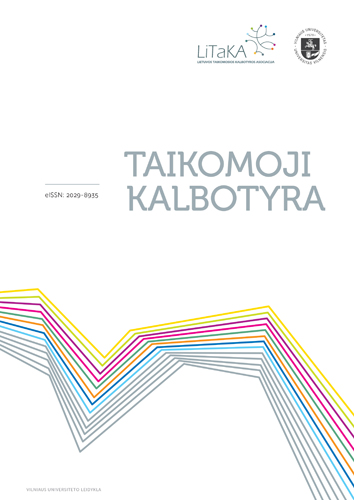Būdingųjų vilniečių tarties bruožų beieškant: 25–35 metų vilniečių balsių trumpinimo polinkiai
In search of pronunciation peculiarities characteristic to Vilnians: vowel shortening tendencies of Vilnians aged 25–35
Author(s): Daiva AliūkaitėSubject(s): Sociolinguistics, Descriptive linguistics
Published by: Vilniaus Universiteto Leidykla
Keywords: Vilnius variant; spontaneous speech; phonological variable; (un)stressed position; instrumental analysis; auditory analysis; characteristic peculiarity; shortened variants;
Summary/Abstract: The article discusses the question of Vilnius variant exclusivity and covers one fragment of Vilnius as a complex microcosm: exclusivity of Vilnius variant is examined by analysing spontaneous speech among Vilnians aged 25–35. Empirical research units are variants of phonological variables /i•/ and /u•/ in unstressed positions. Applying two different research methods – one based on hearing (auditory) and an instrumental one – the parameter of duration of these long vowels was evaluated in the spontaneous speech of the interviewed Vilnians aged 25-35. The results of the auditory research and instrumental examination (instrumental checks of almost 800 variants of phonological variables /i•/ and /u•/ in unstressed positions and 384 variants in stressed positions have been carried out) demonstrate that shortened variants of variables /i•/ and /u•/ in unstressed positions are characteristic of the language of the research group. Unstressed variants of the variables under investigation cover the duration continuum range between 60 and 80 milliseconds. Duration range of the variants of variables /i•/ and /u•/ in stressed positions starts at approx. 90 ms. Duration data of variants /i•/ and /u•/ in stressed and unstressed positions was correlated and this correlation reveals that duration areas of these variants almost overlap. Transitional zone is between ~80 and 90 ms. Quantitative reduction is very apparent so it is possible to make an assumption that this tendency reflects this particular peculiarity of the language specific to Vilnians. However, it is essential to state that even after shortened variants of variables /i•/ and /u•/ in unstressed positions are present in the speech of people belonging to different generations or having different sociolinguistic portraits, this characteristic cannot be considered as a distinctive characterization of Vilnius language (Vilnius variant). Distinguishing features in variability analysis cannot be at the same time primary, i. e. distinctive, as well as tertiary, i. e. denoting, characteristic. In this research this would be the case. The value of tertiary features is characteristic of quantitative (shortened) variants of variables /i•/ and /u•/ in some dialects. Therefore methodologically it is not accurate to evaluate vowel shortening tendency of Vilnians as distinctive characteristics specific to the people of Vilnius. These features are characteristic, but they do not have a clear single-plan dividing power.
Journal: Taikomoji kalbotyra
- Issue Year: 2014
- Issue No: 6
- Page Range: 1-33
- Page Count: 33
- Language: Lithuanian

